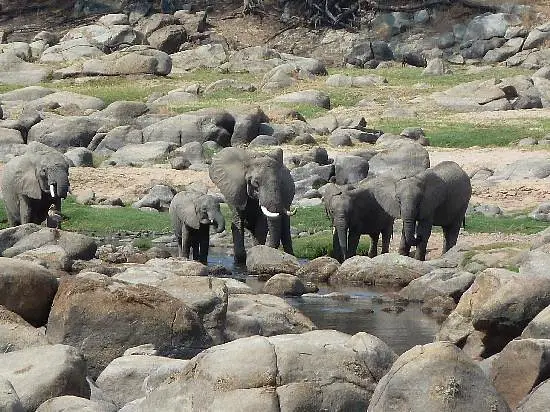Tanzania, a captivating East African nation, boasts an abundance of natural wonders, cultural heritage, and thrilling adventures. From the vast plains of Serengeti National Park to the majestic heights of Mount Kilimanjaro, Tanzania offers a diverse array of experiences that will leave visitors in awe.
This article will take you on a journey through the best places to visit in Tanzania, uncovering its breathtaking landscapes, magnificent wildlife, and rich cultural treasures.
Serengeti National Park

Covering an area of approximately 14,750 square kilometers (5,700 square miles), Serengeti National Park is a vast wilderness that stretches across the Serengeti ecosystem. The park itself is part of a larger ecosystem that includes neighboring protected areas such as the Ngorongoro Conservation Area and the Maasai Mara National Reserve in Kenya.
Serengeti National Park is famous for being the stage for the Great Migration, one of the most spectacular wildlife events on the planet. Every year, millions of wildebeest, along with zebras and gazelles, undertake a remarkable journey in search of fresh grazing lands. This epic migration follows a circular route that takes the animals from the southern plains of the Serengeti to the northern reaches and back again, crossing treacherous rivers and facing predation along the way.
The Serengeti is home to an incredible diversity of wildlife, making it a paradise for wildlife enthusiasts. The park boasts the African Big Five, including lions, elephants, leopards, rhinos, and buffalos. Other commonly spotted species include cheetahs, hyenas, giraffes, zebras, wildebeest, and various antelope species. Birdwatchers will also be delighted by the park’s abundant birdlife, with over 500 bird species recorded.
Mount Kilimanjaro

Mount Kilimanjaro is located in northeastern Tanzania, near the border with Kenya. It is part of Kilimanjaro National Park, a UNESCO World Heritage site. The mountain consists of three volcanic cones: Kibo, Mawenzi, and Shira. The highest point is Uhuru Peak on the Kibo cone, standing at an impressive elevation of 5,895 meters (19,341 feet) above sea level.
Mount Kilimanjaro offers several routes to reach the summit, catering to different levels of experience and physical fitness. The most popular routes include the Marangu Route, Machame Route, Lemosho Route, Rongai Route, and the Northern Circuit. Each route has its own unique features, duration, and difficulty level, ranging from 5 to 9 days.
Mount Kilimanjaro is considered a non-technical climb, which means it does not require advanced mountaineering skills or equipment like ropes or ice axes. However, it is a challenging trek due to the high altitude and steep terrain. Proper acclimatization and physical fitness are crucial for a successful summit attempt. It is recommended to undertake a gradual ascent to allow the body to adjust to the altitude.
Climbing Mount Kilimanjaro offers a unique opportunity to experience distinct ecological zones. The trek begins in the lush rainforest zone, characterized by dense vegetation and a variety of wildlife, including monkeys and colorful bird species. As you ascend, you enter the heath and moorland zone, where vegetation becomes more sparse, and you may encounter unique plant species like giant lobelias. Above this lies the alpine desert zone, characterized by rocky landscapes and sparse vegetation. Finally, the summit zone is a snow-capped peak with arctic conditions.
Mount Kilimanjaro’s scenic beauty is awe-inspiring. The trek offers breathtaking views of the surrounding landscapes, including sweeping vistas of the Tanzanian savannah, neighboring peaks, and the vast expanse of the African continent. The sunrise and sunset views from the mountain are particularly stunning, with the changing hues painting the sky in vibrant colors.
Zanzibar
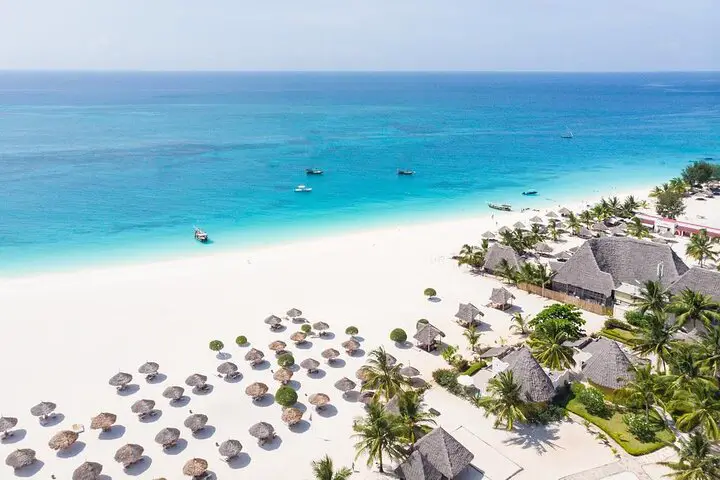
Zanzibar consists of several islands, with the main ones being Unguja (referred to as Zanzibar Island) and Pemba Island. Zanzibar Island is the largest and most popular destination, known for its stunning white-sand beaches, turquoise waters, and thriving coral reefs.
Zanzibar is renowned for its picturesque beaches, with powdery white sands and crystal-clear waters. Popular beach destinations include Nungwi, Kendwa, Paje, and Jambiani. These beaches offer opportunities for sunbathing, swimming, snorkeling, and diving. The coral reefs around Zanzibar are home to a diverse array of marine life, making it a haven for underwater exploration.
Zanzibar’s nickname, the “Spice Island,” reflects its rich agricultural heritage. Spice tours allow visitors to explore spice plantations, learn about the cultivation of cloves, nutmeg, cinnamon, and other aromatic spices, and engage in sensory experiences by smelling and tasting the fresh spices.
Traditional Arab sailing vessels known as dhows offer scenic cruises along the Zanzibar coast. Visitors can enjoy the tranquility of the Indian Ocean, witness stunning sunsets, and even spot dolphins swimming alongside the boat.
Located on Zanzibar Island, Jozani Forest is a protected area known for its unique biodiversity. It is home to the endangered Zanzibar red colobus monkeys, as well as other primate species, butterflies, and birdlife. Visitors can take guided walks through the forest and learn about its ecology and conservation efforts.
Ngorongoro Conservation Area
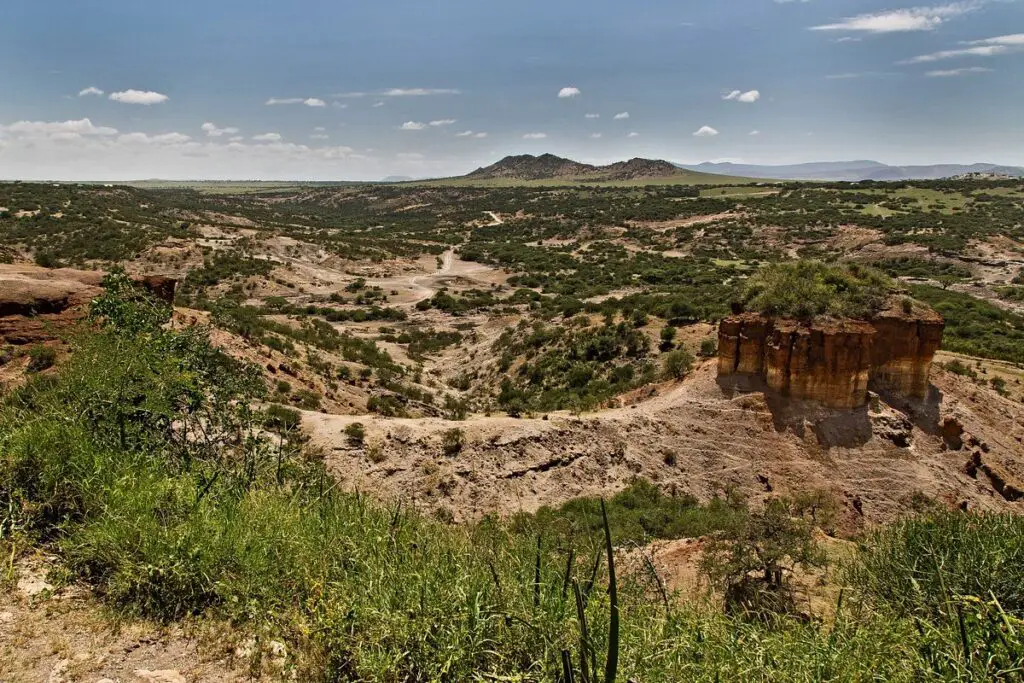
The Ngorongoro Conservation Area is situated in the Crater Highlands region, encompassing an area of approximately 8,292 square kilometers (3,202 square miles). The centerpiece of the conservation area is the Ngorongoro Crater, a large volcanic caldera that formed over two million years ago when a massive volcano collapsed. Today, the crater is a natural amphitheater, spanning 260 square kilometers (100 square miles) and hosting a diverse range of ecosystems.
The Ngorongoro Crater is a world-renowned natural wonder and a UNESCO World Heritage site. It is often referred to as the “Eighth Wonder of the World.” The crater floor is home to an abundance of wildlife, including large herds of wildebeest, zebras, buffalos, and gazelles. Predators such as lions, cheetahs, and hyenas can also be spotted, along with a rich array of bird species. The unique topography of the crater creates a microcosm of diverse habitats, from open grasslands to freshwater lakes and marshes.
Exploring the Ngorongoro Crater on a game drive is a thrilling experience. Visitors have the opportunity to witness an incredible concentration of wildlife in a relatively small area. The chances of encountering the “Big Five” (elephants, lions, leopards, rhinos, and buffalos) are high. The crater’s enclosed nature and the abundance of water sources make it an ideal habitat for diverse wildlife populations.
Located within the Ngorongoro Conservation Area, the Olduvai Gorge is an important archaeological site known as the “Cradle of Mankind.” It has provided valuable insights into human evolution and is one of the world’s most significant paleoanthropological sites. Excavations in the area have uncovered fossilized remains of early hominids, including the famous discoveries of Homo habilis and Homo erectus.
Tarangire National Park
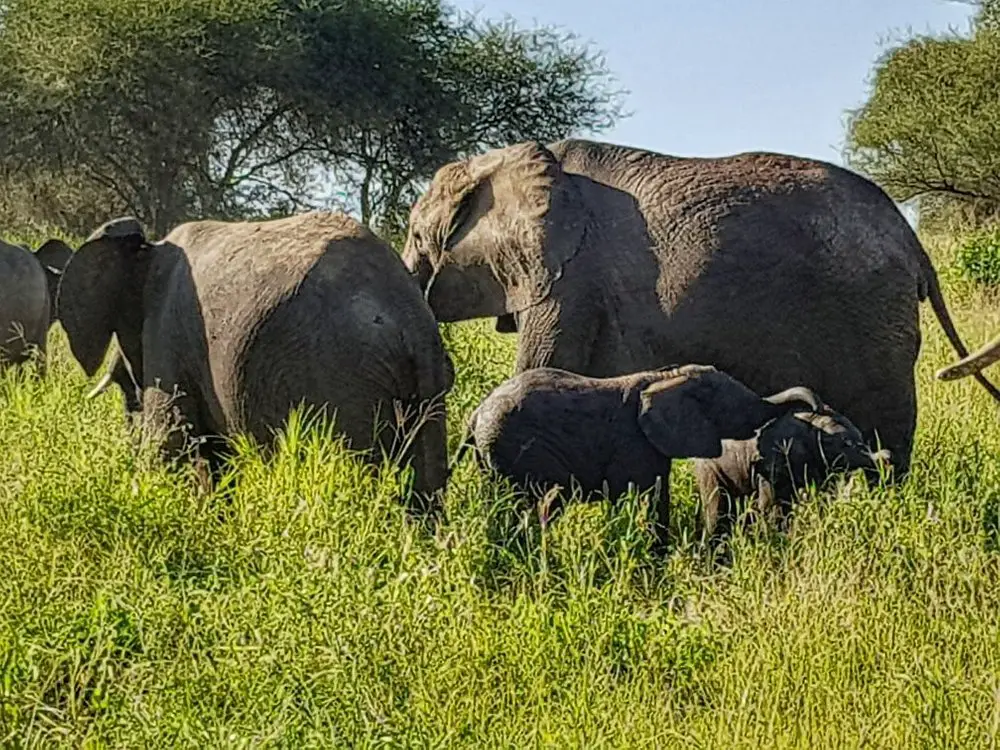
Tarangire National Park is characterized by its diverse landscapes, which include vast grasslands, acacia woodlands, seasonal marshes, and the Tarangire River. The river is the lifeline of the park, providing water for the abundant wildlife, particularly during the dry season. The park is also known for its iconic baobab trees, which dot the landscape and create a unique and picturesque setting.
Tarangire National Park is renowned for its rich wildlife populations. The park is home to a wide variety of animals, including large herds of elephants, wildebeest, zebras, giraffes, buffalos, and impalas. Predators such as lions, leopards, and cheetahs are also found in the park. Tarangire is especially known for its large elephant herds, making it one of the best places in Tanzania to witness these magnificent creatures up close. The park is also a bird lover’s paradise, with over 500 bird species recorded, including the endemic yellow-collared lovebird and ashy starling.
Tarangire National Park offers exceptional game drives and safari experiences. Visitors can embark on thrilling game drives across the park’s vast savannahs and woodlands, encountering a wide array of wildlife. The dry season, from June to October, is particularly rewarding for wildlife viewing as animals gather around the Tarangire River, creating incredible wildlife concentrations.
In addition to traditional game drives, Tarangire National Park offers unique experiences such as walking safaris and night drives. Walking safaris allow visitors to explore the park on foot, accompanied by experienced guides, providing an intimate and immersive encounter with nature. Night drives provide an opportunity to observe nocturnal wildlife that is rarely seen during daytime game drives, such as hyenas, porcupines, and lesser bushbabies.
Lake Manyara National Park

Lake Manyara National Park is a stunning wildlife destination located in northern Tanzania, at the base of the Great Rift Valley. Here’s more information about Lake Manyara National Park:
Location and Size: Lake Manyara National Park covers an area of approximately 330 square kilometers (127 square miles) and is located about 126 kilometers (78 miles) west of Arusha. The park is situated between the dramatic escarpment of the Great Rift Valley and Lake Manyara itself.
Scenic Beauty and Ecosystems: Lake Manyara National Park is known for its picturesque landscapes and diverse ecosystems. The park’s most prominent feature is Lake Manyara, a shallow alkaline lake that stretches along the park’s western boundary. The lake attracts a wide variety of birdlife, including flamingos, pelicans, and storks. The park also encompasses diverse habitats, ranging from open grassy plains to dense woodlands and the impressive groundwater forest at the base of the Rift Valley escarpment.
Despite its relatively small size, Lake Manyara National Park is home to a remarkable array of wildlife. The park is known for its tree-climbing lions, a unique behavior rarely seen in other parts of Tanzania. Other wildlife species that can be spotted in the park include elephants, buffalos, giraffes, zebras, hippos, and various antelope species such as impalas and waterbucks. Lake Manyara is also famous for its large population of baboons, whose interactions and behaviors can be observed throughout the park.
One of the unique experiences offered in Lake Manyara National Park is canoeing and boat safaris on Lake Manyara itself. These activities allow visitors to explore the lake up close, witnessing the abundant birdlife and potentially spotting hippos and other aquatic creatures. Canoeing and boat safaris provide a different perspective and a tranquil way to appreciate the park’s beauty.
Lake Manyara National Park also offers guided walking safaris, allowing visitors to explore the park on foot with experienced guides. Walking safaris provide opportunities for close encounters with wildlife and a chance to learn about the park’s flora and fauna. Additionally, cultural interactions with local communities, such as the Maasai, can be arranged to learn about their traditional way of life, customs, and cultural practices.
Ruaha National Park

Ruaha National Park is renowned for its diverse and striking landscapes. The park features a rugged terrain characterized by rolling hills, vast plains, and rocky outcrops. It is traversed by the Great Ruaha River, which forms the lifeline of the park, attracting a concentration of wildlife during the dry season. Ruaha’s landscape showcases a mix of miombo woodlands, riverine forests, and open savannahs, providing a diverse and picturesque backdrop for wildlife viewing.
Ruaha National Park is renowned for its incredible wildlife diversity and is often referred to as the “Giraffic Park” due to its large population of giraffes. The park is home to a wide range of wildlife, including large elephant herds, lions, leopards, cheetahs, zebras, buffalos, giraffes, and various antelope species. Ruaha is also a haven for bird enthusiasts, with over 570 bird species recorded in the park, including the iconic African fish eagle, secretary bird, and lilac-breasted roller.
The Park offers exceptional game drives and safari experiences. The park’s vast and remote nature ensures a more exclusive and off-the-beaten-path safari experience. Game drives provide the opportunity to encounter wildlife in their natural habitats, with excellent chances of spotting predators and other iconic African species. The park’s expansive landscapes and lower visitor numbers contribute to a sense of wildness and wilderness.
Ruaha National Park allows visitors to explore its wilderness on foot through guided walking safaris. Walking safaris provide an immersive and intimate experience, allowing for a deeper connection with nature and a chance to appreciate the smaller details of the ecosystem. Additionally, bush camping is permitted in designated areas of the park, offering adventurous travelers the opportunity to spend a night under the starry African sky.
Although Ruaha National Park is more remote than some other Tanzanian parks, it is accessible by road and air. There are several airstrips within or near the park that cater to flights from major cities and other destinations in Tanzania. The park offers various accommodation options, including lodges, tented camps, and campsites, providing a range of choices for different budgets and preferences.
Mafia Island
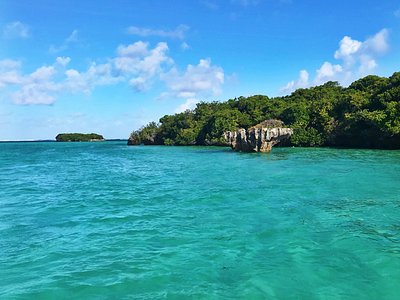
Mafia Island is part of the Mafia Archipelago, situated about 120 kilometers (75 miles) south of Dar es Salaam. It is the largest island in the archipelago and covers an area of approximately 394 square kilometers (152 square miles). The island can be reached by a short flight from Dar es Salaam or by a combination of flight and boat transfer from Zanzibar.
Mafia Island is renowned for its pristine beaches, crystal-clear turquoise waters, and vibrant coral reefs. The island offers an idyllic tropical escape with its palm-fringed shores, mangrove forests, and lush vegetation. The marine environment around Mafia Island is a marine reserve and part of the Mafia Island Marine Park, which is known for its exceptional biodiversity and remarkable marine life. The coral reefs teem with colorful fish, turtles, dolphins, and a variety of other marine species, making it a popular destination for snorkeling, diving, and swimming.
Mafia Island is a haven for diving and snorkeling enthusiasts. The surrounding waters boast a rich and diverse underwater ecosystem, including a range of coral formations, reef walls, and underwater caves. The marine park is home to over 400 species of fish and 48 genera of hard coral. Divers can explore magnificent sites such as Coral Gardens, Kinasi Pass, and Chole Bay, which offer opportunities to encounter vibrant coral gardens, large schools of fish, and even the occasional encounter with whale sharks or manta rays.
Mafia Island is renowned for its incredible opportunities to witness whale sharks and humpback whales. Between October and March, whale sharks gather near the island, providing a unique chance to swim alongside these gentle giants. From June to September, humpback whales can be spotted as they pass through the area during their migration. Boat trips are organized to get closer to these majestic creatures, allowing visitors to observe them in their natural habitat.
Tanzania is a land of awe-inspiring landscapes, rich biodiversity, and cultural treasures waiting to be discovered. From the iconic Serengeti to the serene beaches of Zanzibar, each destination offers its unique allure. Whether you seek thrilling wildlife encounters, challenging mountain summits, or blissful relaxation, Tanzania’s best places provide a wealth of unforgettable experiences. Embrace the spirit of adventure and immerse yourself in Tanzania’s natural masterpiece – a journey that will leave you with memories to cherish for a lifetime.

